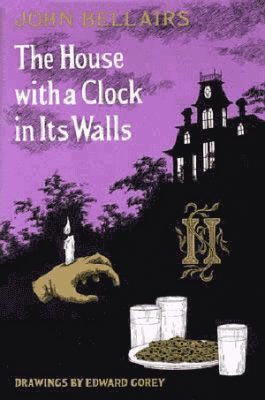Reviewer: Emera
Date read: 1.30.2016
Book from: Personal collection
Orphaned Lewis Barnavelt comes to live with his Uncle Jonathan and quickly learns that both his uncle and his next-door neighbor are witches on a quest to discover the terrifying clock ticking within the walls of Jonathan’s house. Can the three of them save the world from certain destruction?
Bellaaaairs! Such a landmark of my childhood spookyscape. When I was in elementary school, I was already obsessed with spooky shit, even though I was also too weak of constitution to not end up with nightmares for a month after reading something particularly choice. Poe at 9 years old was one high-water mark; Bellairs at 10 or 11 was another. (Isn’t even just the name Bellairs perfect? So rich and old-world; it sounds like old libraries with bell-pulls.)
Bellairs’ preoccupation with the occult was, I think, several layers more complex and esoteric than the more traditional ghost stories I typically found in the library, and correspondingly struck me as something much wickeder, with potentially apocalyptic consequences. Even though M. R. James is considered Bellairs’ most immediate stylistic influence, in my head he’s more immediately the YA answer to Lovecraft (who is also a James descendant, of course). I hadn’t ever encountered something like his red doomsday skies, resurrected corpses, and convincingly evil necromancers before. That mixture of human wickedness and imminence of the terrible sublime – very Lovecraftian, it seems to me.
The withered Gorey illustrations, were, needless to say, the cherry on top of my morbid fascination. (I think it’s a shame that the recent reeditions did away with the Gorey covers – the new ones are creepy in a rather detached, less involving way.)
Un/luckily these are no longer traumatizingly scary, but they still hit the YA spot – clever, brisk, suspenseful, and full of curious, satisfying period details. I read that Bellairs based the 1940’s setting heavily on his childhood memories, and it shows in the detailing of Lewis’ neighborhood and the surrounding countryside – I thought the long overnight countryside car chase sequence in this book was notably, surreally beautiful:
The car raced on, spitting stones from under its tires. Down into hollows bordered by dark skeletal trees, up over high hills, on and on while the setting moon seemed to race to keep up with them. They covered a large part of Capharnaum County that night, because the way around was a long way. After what seemed like hours of driving, they came to a place where three roads met. As the car screeched around the turn, Lewis saw – for a few seconds – a Civil War cannon white with frost, a wooden church with smeary stained-glass windows, and a general store with a dark glimmering window that said: SALADA.
Bellairs also shines in that he refuses to talk down to a younger audience, freely seeding the book with flavorful historical and artistic references – there’s a delightful and so-apt bit, for example, about Mrs. Zimmerman, the next-door witch, having a “large surrealistic painting of a dragon … [that] had been done for her specially by the French painter Odilon Redon.”
The only place where I felt a bit let down was in how perfunctory the characterizations felt. The characters are crisply drawn (Lewis is chubby and constitutionally sad and left-out; his Uncle Jonathan is charmingly blustery; etc.) but, for this adult reader, not terribly compelling; they felt a bit like placeholders to me. On reflection, I suspect this may be symptomatic of the book’s very short length, more than any immediate creative faults on Bellairs’ part. So there’s a significant part of me that wishes that we could also sample from the universe where Bellairs, as originally intended, had been allowed to publish his series as horror novels for adults.
Given that unfortunate impossibility, I might have to see about gradually collecting his books in the original Gorey editions. Gimme those mummies and talismans!
Go to:
The Haunted Dolls’ House and Other Ghost Stories, by M. R. James (1919, 1925): review by Emera

Awww you did end up rereading this! I am so eager to pick this up now, especially since all my bookish adult friends seem to have gone through a delicious Bellairs phase.
Unfortunately, I have finally accepted that characterizations tend to be prefunctory in my YA rereads… at least more so than when i first read them. I think it’s a symptom of length and audience…. maybe not so bad. Certainly useful in a Book of Virtues way for younger children?
Also… isn’t it crazy how the stuff that actually scares you has evolved so much?
Please do read this! (Can I mail-lend you my copy?) You would love it so much, especially now that it’s October. It’s a perfect one-rainy-afternoon read.
I think it’s a symptom of length and audience
I’m still agonizing over whether this must be so! I feel like it simply doesn’t have to be the case because there are so many YA novels with characters that follow you around for days afterward. But of course different books are trying to do different things.
useful in a Book of Virtues way
I think when we’re smaller it’s also just so much easier to invest even slight suggestions of emotion, sensation, or character with so much more depth and breadth.
Kakaner, I am SO BUMMED over how desensitized I’ve become to scary things. I’ve been loading up on ghost stories (again, because it’s October), and I wish I could lower my threshold for subtly creepy things again because neither Machen nor James have been doing for me, and that’s just not right.